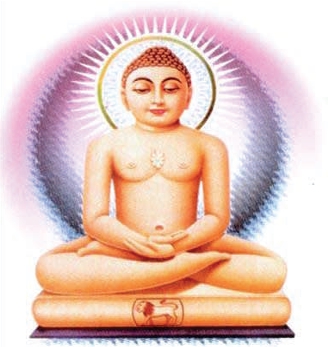
Concept of God in Jainism
Jainism believes that universe and all its substances or entities are eternal. It has no beginning or end with respect to time. Universe runs own its own accord by its own cosmic laws. All the substances change or modify their forms continuously. Nothing can be destroyed or created in the universe. There is no need of some one to create or manage the affairs of the universe. Hence Jainism does not believe in God as a creator, survivor, and destroyer of the universe.
However Jainism does believe in God, not as a creator, but as a perfect being. When a person destroys all his karmas, he becomes a liberated soul. He resides in a perfect blissful state in moksha. He possesses infinite knowledge, infinite vision, infinite power, and infinite bliss. This living being is a God of Jain religion.
Every living being has a potential to become God. Hence Jains do not have one God, but Jain Gods are innumerable and their number is continuously increasing as more living beings attain liberation.
Jains believe that since the beginning of the time every living being (soul) because of its ignorance, is associated with karmas. The main purpose of the religion is to remove these karmas which are attached to the soul and become liberated soul.
There are many types of karmas. However they are broadly classified into the following eight categories:
1.
Mohniya karma
It generates delusion in the soul in regard to its own true nature, and makes it identify itself with other external substances.
2.
Jnana-varaniya karma
It covers the soul's power of perfect knowledge.
3.
Darasna-varaniya karma
It covers the soul's power of perfect visions.
4.
Antaraya karma
It obstructs the natural quality or energy of the soul such as charity and will power. This prevents the soul from attaining liberation. It also prevents a living being from doing something good and enjoyable.
5.
Vedniya karma
It obscures the blissful nature of the soul, and thereby produces pleasure and pain.
6.
Nama karma
It obscures the non-corporeal existence of the soul, and produces the body with its limitations, qualities, faculties, etc.
7.
Gotra karma
It obscures the soul's characteristics of equanimity, and determines the caste, family, social standing, and personality.
8.
Ayu karma
It determines the span of life in one birth, thus obscuring soul's nature of eternal existence.
While travelling on the path of spiritual progress, a person destroys all eight types of his karmas in the following sequence:
- First Mohaniya (delusion),
- then Jnana-varaniya (knowledge), Darasna-varaniya (vision), and
- Antaraya (natural qualities) all three together.
At this time, he attains keval-jnana and he is known as Arihant. Arihant is also known as Tirthankara, Jina, Arhat, Kevali, or Nirgantha.
Lastly the remaining four karmas namely Vedniya (pleasure and pain of the body), Nama (body), Gotra (social standing), and Ayu (life span) are destroyed. At this time, he attains total liberation and he is known as Siddha.
The first four karmas are called Ghati karmas because they obscure the natural qualities of the soul. The last four karmas are known as Aghati karmas because they do not affect the qualities of the soul, but they are related to the physical body of the soul. Once a person destroys all his Ghati karmas, he will definitely destroy all of his Aghati karmas before his death. No fall back can occur after the destruction of Ghati karmas.
I. Arihant:When a person destroys his four Ghati karmas, he attains keval-jnana. He has regained the original attributes of his soul, which are perfect knowledge, vision, power, and bliss. He is omniscient of the past, present and future forms of all entities (living and nonliving beings) of the universe. He is still a human being. He remains in the state of blissful condition for the rest of his life. Arihants are classified into two categories:
- Tirthankar
- Ordinary-kevali
A. Tirthankar:Immediately after attaining keval-jnana, if a person establishes the four-fold religious order of monks, nuns, sravaks (male laypeople), and sravikas (female laypeople) is known as Tirthankar. He preaches the Jain philosophy, religion, ethics, conducts to his followers.
Jainism believe that Twenty-four Tirthankars are born during each descending and ascending part of the time cycle in this region (Bharat Kshetra) of the universe. No two Tirthankaras exist at the same time. Generally a Tirthankara is born when the religion is at its depression state. The new Tirthankar revives the same Jain philosophy. He gives a different form to the religion practice depending upon the time, place, and the social behavior of the human society.
Example:B. Ordinary kevaliLord Mahavir preached five great vows, while Lord Parshva preached four great vows. The vow of celibacy was included in the non-possession category by Lord Parshva.
The only difference between Tirthankara and ordinary kevali is that the latter does not establish the religious order. He remains in the state of perfect blissful condition for the rest of his life after attaining keval-jnana.
In the religious scriptures, the name Arihantas and Tirthankaras are interchangeably used because ordinary-kevalis do not play any active roles in the religious order. Tirthankar is also known as
Tirthankara:
- Jina,
- Arihant,
- Arhat,
- Arhant, or
- Nirgrantha.
Founder of four-fold order of monks, nuns, laymen, and laywomen.
a. Jina:One who has conquered his, inner passions such as desire and hatred.
b. Arihant:One who has destroyed his inner enemies such as greed, anger, desire, and hatred.
c. Arhat:One to whom nothing can be secret.
d. Arhant:II. SiddhaA spiritual acquirement leading a man to the state of an Arihant.
e. Nirgrantha:A religion of One who has gotten rid of all knots or attachments.
Both the Tirthankara and ordinary-kevali destroy the remaining four Aghati karmas at the end of their present life. After their nirvan (death) all of them are known as Siddhas. They are totally free and liberated. They are free from the birth and death cycle. They do not possess body. They do not feel pleasure and pain, or joy and sorrow. They live in an ever-lasting blissful condition at the top of the universe (Lokakas) known as Moksha.
The quality and attributes of all siddhas are same. However, they still maintain their unique identity and form.
Example:III. Jain Gods:Lord Mahavir's soul as a siddha possesses the same qualities as of Shri Gautam Swami or Shri Bahubali's soul. However their souls remain unique individual and have different forms.
Both Arihants and Siddhas are considered Gods of Jain religion. Arihats are perfect human beings and preach the Jain religion to the people during their remaining life. After death they become Siddhas. All Siddhas are perfected souls, living for ever in a blissful state in Moksha.
Question:Answer:In the Namokar Mantra we pray to the Arihants (Tirthankara) first and then to the Siddhas second. Even though the Siddhas are perfected souls, have destroyed all (both Ghati and Aghati) Karmas, and are at the highest spiritual stage. While the Arihantas have destroyed only four Ghati Karmas and are at a lower (thirteen gunasthan) spiritual stage.
IV. The Four-Fold order a. Monks and Nuns (ascetics):It is because Arihants after attaining keval-jnana (after destroying four ghati-karmas), establish the four fold order of Jain religion. They preach the Jain philosophy, ethics and conduct. They explain the path of liberation and the qualities of the perfected soul or Siddhas. Without the teachings of Arihantas we would not have known Siddhas or liberation. For this reason we pray Arihantas first and Siddhas second.
b. Sravaks and Sravikas (lay followers):They practice self-control and have given up all desires and earthly possessions become the spiritual practicer and teachers. They follow strictly five great vows (maha-vrats).
They are not required to renounce the world, but are expected to discharge household duties by honest means and live a progressive pure life. They follow the twelve vows of lay people.
 Pravin K. Shah
Pravin K. Shah